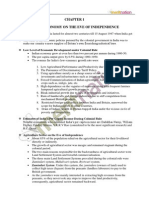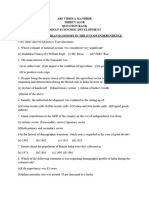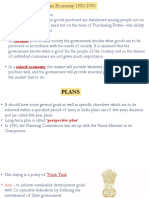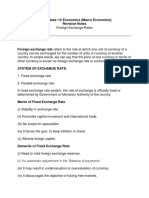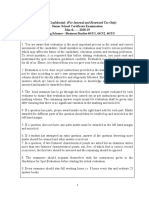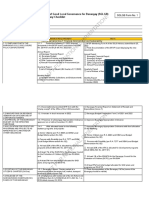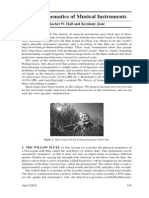Professional Documents
Culture Documents
Economics Notes PDF Class 12 Indian Economy On The Eve of Independence
Economics Notes PDF Class 12 Indian Economy On The Eve of Independence
Uploaded by
Man your voice is breaking kuttyOriginal Description:
Original Title
Copyright
Available Formats
Share this document
Did you find this document useful?
Is this content inappropriate?
Report this DocumentCopyright:
Available Formats
Economics Notes PDF Class 12 Indian Economy On The Eve of Independence
Economics Notes PDF Class 12 Indian Economy On The Eve of Independence
Uploaded by
Man your voice is breaking kuttyCopyright:
Available Formats
Follow us on Facebook CommerceLerning.
com Join us on Telegram
es
ss
la
C
ce
Economics Notes PDF
er
m
On
om
Indian Economy on the Eve of Independence
C
(Class – 12)
For More Notes PDF: CommerceLerning.com
Follow us on Facebook CommerceLerning.com Join us on Telegram
INTRODUCTION
The current nature of the Indian economy is not solely owing to its current creation; its roots are deeply rooted in
our history, i.e. India's past, particularly during the period when India was under British dominion. The reign lasted
around two centuries. The Indian economy was in disarray on the brink of independence. In order to have a
brighter future for ourselves and future generations, we as a country have to start from scratch and all over again.
Our desire to obtain information and understanding was also stifled by 200 years of British control. We were
denied an education because we were held as slaves by our oppressors. As a result of their acts, we were illiterate
by the end of their rule. On the eve of independence, the Indian economy was brimming with people who had no
idea how to serve the country.
es
LOW LEVEL OF ECONOMIC DEVELOPMENT
● The colonial govt., never made any sincere attempt to estimate India’s national and per capita income.
ss
● The estimates given by Dr. V.K.R.V. Rao suggested that the growth rate of GDP was about 2% per annum
while the growth of per capita output was just 1/2 (0.5) percent per annum.
● Since high-quality materials were employed and a high standard of craftsmanship was evident in all Indian
imports, Indian products had a global market.
la
● The economic policies of the colonial government were highly influenced by the self-centered economic
interests.
AGRICULTURE SECTOR
●
●
C
Around 85% of the Indian population was dependent on agriculture during colonial rule.
Agricultural productivity became low. The sector experienced some growth due to various systems of land
ce
settlements which led to expansion of aggregate area under cultivation.
● High yield of cash crops in certain areas were observed due to commercialisation of agriculture.
● There was little progress in irrigation still the sector suffered due to lack of investment in terracing, flood
control, drainage and desalination of soil.
er
INDUSTRIAL SECTOR
m
● De-industrialization- Decline of Indian handicraft industry.
● Capital goods industries were lacking
● Limited operation of public sector
● Discriminatory tariff policy.
om
● Competition from Machine made products
● Introduction of Railways in India
● Lack of Heavy and Basic Industries
FOREIGN TRADE
C
● The structure, composition and volume of India's foreign trade was adversely affected by the restrictive
policies of the commodity production, trade and tariff of the colonial government.
● Primary products such as silk, cotton, wool, sugar jute, Indigo were exported from India.
● Foreign trade was largely restricted to Britain, with only a handful of countries such as China, Sri Lanka,
and Persia (Iran) being permitted.
For More Notes PDF: CommerceLerning.com
Follow us on Facebook CommerceLerning.com Join us on Telegram
● The Indian economy was gravely exploited by the British government which led to the drain of Indian
wealth.
DEMOGRAPHIC CONDITION
● High death and Birth rate-40 and 48 per thousand respectively.
● High infant mortality rate-218 per thousand.
● Mass Illiteracy-84% illiterate.
● Low life expectancy- 44 years
● Low standard of living- People used to spend 80% to 90% of their income on basic needs.
es
● Lack of public health facilities
● Female Literacy level was about 7%.
OCCUPATIONAL STRUCTURE
ss
During the colonial period, the occupational structure of India exhibited its backwardness. The agricultural sector
accounted for the largest share of the work force which remained at a high of 70-75% of the work force and the
manufacturing and services sectors accounted for only 10 and 15-20% respectively.
There existed a growing regional disparity with few states such as Orissa, Rajasthan and Punjab witnessing an
la
increase in agricultural workforce while the states which were the parts of Madras presidency. Bombay and Bengal
witnessed a decline in the percentage of the work force dependent on agriculture.
INFRASTRUCTURE
C
Absence of good roads, electricity generation, health, education and communication. However, some efforts have
been made to develop basic infra-structure like roads, railways, ports, water transport, post & telegraph by the
British rulers. The main motive was not to provide basic amenities to the Indian people but for their colonial
ce
interest.
CONCLUSION
By the time India won its independence, the impact of the two-century long British colonial rule was already
er
showing on all aspects of the Indian economy. The agricultural sector was already saddled with surplus labour and
extremely low productivity. By the time India won its independence, the impact of the two-century long British
colonial rule was already showing on all aspects of the Indian economy. The agricultural sector was already
m
saddled with surplus labour and extremely low productivity.
om
Follow on Facebook Follow on Instagram Join us on Telegram
C
For More Notes PDF: CommerceLerning.com
You might also like
- Rat Control GuidanceDocument67 pagesRat Control GuidanceAardwolf PestkareNo ratings yet
- Chapter 2 - Indian Economy 1950-1990Document10 pagesChapter 2 - Indian Economy 1950-1990ARNAVNo ratings yet
- Physics WEB PDFDocument850 pagesPhysics WEB PDFKiron Sheiq100% (1)
- Unit I - Indian Economy On The Eve of IndependenceDocument3 pagesUnit I - Indian Economy On The Eve of IndependenceJay Karta0% (1)
- Indian Economy On The Eve of IndependenceDocument25 pagesIndian Economy On The Eve of IndependenceCharu Anand Mittal100% (4)
- Indian Eco Chapter 2 - NotesDocument5 pagesIndian Eco Chapter 2 - NotesShivam MutkuleNo ratings yet
- Rural Development PDFDocument3 pagesRural Development PDFJatin VandrankiNo ratings yet
- Ch-3 of Indian Economy NotesDocument6 pagesCh-3 of Indian Economy NotesAyush LohiyaNo ratings yet
- Rural Development - Handwritten Notes - (Kautilya)Document14 pagesRural Development - Handwritten Notes - (Kautilya)akshat jainNo ratings yet
- 12 Economics Notes Macro Ch02 Money and BankingDocument6 pages12 Economics Notes Macro Ch02 Money and BankingRitika50% (2)
- Class 12th Economic Macro NotesDocument134 pagesClass 12th Economic Macro NotesKhusi Agrawal100% (1)
- 12 Economics - Human Capital Formation in India - Notes & Video LinkDocument7 pages12 Economics - Human Capital Formation in India - Notes & Video LinkA.Mohammed Aahil100% (1)
- Human Capital Formation in IndiaDocument18 pagesHuman Capital Formation in IndiaSayma ShaikhNo ratings yet
- Class 12 Human Capital FormationDocument4 pagesClass 12 Human Capital FormationAryan ph vlogsNo ratings yet
- Work Sheet - 1 Indian Economy On The Eve of IndependenceDocument33 pagesWork Sheet - 1 Indian Economy On The Eve of IndependenceAditya Shrivastava100% (1)
- Indian Economy in The Eve of Independence - Question BankDocument4 pagesIndian Economy in The Eve of Independence - Question BankHari prakarsh NimiNo ratings yet
- Indian Eco 1950-1990Document25 pagesIndian Eco 1950-1990Shivam Mutkule67% (3)
- Class 12 Foreign Exchange RateDocument4 pagesClass 12 Foreign Exchange RateAryan ph vlogs100% (1)
- Solved Numericals On Various Deficits PDFDocument3 pagesSolved Numericals On Various Deficits PDFTashi Lhamu Tamang100% (2)
- Economics Project DraftDocument32 pagesEconomics Project DraftMadiha Kureshi0% (1)
- Indian Economy-Pre Independace Perion (Sandeep Garg)Document13 pagesIndian Economy-Pre Independace Perion (Sandeep Garg)parthNo ratings yet
- 4 Thinkers, Beliefs, and BuildingsDocument20 pages4 Thinkers, Beliefs, and Buildingssayooj tvNo ratings yet
- Important Questions of Indian Economic Development Chapter 1Document2 pagesImportant Questions of Indian Economic Development Chapter 1Anjali Vyas100% (1)
- Padhle Notes - Elasticity of DemandDocument13 pagesPadhle Notes - Elasticity of DemandAafia100% (1)
- Worksheet On Indian Economy (1950 - 1990)Document2 pagesWorksheet On Indian Economy (1950 - 1990)astuti sharmaNo ratings yet
- Facets of Modernisation - China, Japan and KoreaDocument24 pagesFacets of Modernisation - China, Japan and KoreaSahana100% (6)
- Senior School Certificate Examination March - 2023 Marking Scheme - Business Studies 66/1/1, 66/1/2, 66/1/3Document26 pagesSenior School Certificate Examination March - 2023 Marking Scheme - Business Studies 66/1/1, 66/1/2, 66/1/3bhaiyarakeshNo ratings yet
- Chapter-2-Indian Economy 1950-1990: Case Study Based QuestionsDocument13 pagesChapter-2-Indian Economy 1950-1990: Case Study Based Questionssocial sites100% (2)
- Notes - Diagrammatic PresentationDocument3 pagesNotes - Diagrammatic PresentationdruhiNo ratings yet
- Revision Notes For Class 12 Macro Economics Chapter 2 - Free PDF DownloadDocument17 pagesRevision Notes For Class 12 Macro Economics Chapter 2 - Free PDF DownloadVibhuti BatraNo ratings yet
- BOP Sandeep GargDocument13 pagesBOP Sandeep GargRiddhima Dua100% (1)
- Du Ba Preference Sheet PDFDocument19 pagesDu Ba Preference Sheet PDFAkhil SrivastavNo ratings yet
- Contemporary Employment Situations in IndiaDocument40 pagesContemporary Employment Situations in Indiavikas jamra100% (2)
- Indian Economy On The Eve of IndependenceDocument38 pagesIndian Economy On The Eve of Independencesocial sites100% (5)
- Ch-1 Indian Economy in The Eve of Independance (True or False)Document3 pagesCh-1 Indian Economy in The Eve of Independance (True or False)social sitesNo ratings yet
- Indian Economy 1950-1990Document9 pagesIndian Economy 1950-1990Tarun VermaNo ratings yet
- Padhle 11th - 5 MicroeconomicsDocument9 pagesPadhle 11th - 5 MicroeconomicsVikas KumarNo ratings yet
- Foreign Exchange - Sandeep GargDocument17 pagesForeign Exchange - Sandeep GargRiddhima DuaNo ratings yet
- Ch.1 - Circular Flow of Income - MacroeconomicsDocument16 pagesCh.1 - Circular Flow of Income - MacroeconomicsMayank Mall100% (2)
- Revision Worksheet 2 - Indian Economy On The Eve of IndependenceDocument4 pagesRevision Worksheet 2 - Indian Economy On The Eve of IndependenceSavita ShirkeNo ratings yet
- Indian Economy (Assertion and Reasoning)Document3 pagesIndian Economy (Assertion and Reasoning)Shivam Mutkule0% (1)
- Analysis of Pupil Performance: AccountsDocument43 pagesAnalysis of Pupil Performance: AccountsT.K. MukhopadhyayNo ratings yet
- Indian Economy 1950 1990Document23 pagesIndian Economy 1950 1990Mahi TiwariNo ratings yet
- 12 Economics - Liberalisation, Privatisation and Globalisation An Appraisal - Notes and Video LinkDocument14 pages12 Economics - Liberalisation, Privatisation and Globalisation An Appraisal - Notes and Video Linksayooj tvNo ratings yet
- Ch-1 Indian Economy in The Eve of Independance (Assertion and Reasoning)Document10 pagesCh-1 Indian Economy in The Eve of Independance (Assertion and Reasoning)social sites100% (1)
- Case Study Class 12 IEDDocument7 pagesCase Study Class 12 IEDAkshayaram Viswanathan100% (2)
- Livestock Is The Backbone of Rural IndiaDocument10 pagesLivestock Is The Backbone of Rural IndiaKathan Patel100% (2)
- 12 Accounts Imp Ch3Document11 pages12 Accounts Imp Ch3Ashish GangwalNo ratings yet
- Class Xi Cbse Eco CH - Production Function NotesDocument5 pagesClass Xi Cbse Eco CH - Production Function NotesSamit Sahay100% (3)
- Sandeep Garg Macroeconomics Class 12 Solutions Class 12 Macroeconomics Sandeep Garg Solutions Chapter 3 - National Income and Related AggregateDocument4 pagesSandeep Garg Macroeconomics Class 12 Solutions Class 12 Macroeconomics Sandeep Garg Solutions Chapter 3 - National Income and Related AggregateRaju PattuNo ratings yet
- Cost Concepts in EconomicsDocument18 pagesCost Concepts in EconomicsHimaani ShahNo ratings yet
- Applied: Mathematics Project WorkDocument18 pagesApplied: Mathematics Project WorkAnusha GhoshNo ratings yet
- Nature & Significance of ManagementDocument25 pagesNature & Significance of ManagementAditi Mahale83% (6)
- Indian Economic Development Notes and Q/A BookletDocument72 pagesIndian Economic Development Notes and Q/A BookletKashvi ChakrawalNo ratings yet
- History Project On MesopotamiaDocument12 pagesHistory Project On MesopotamiaSaraswata Basu100% (2)
- Ms Business Studies Set 66-3-1,2,3 2019Document74 pagesMs Business Studies Set 66-3-1,2,3 2019Navya JindalNo ratings yet
- CBSE Class-11 Economics Revision Notes Ecomomics 01 Introduction To Micro EconomicsDocument6 pagesCBSE Class-11 Economics Revision Notes Ecomomics 01 Introduction To Micro EconomicsVishakha Bhayana50% (2)
- Numericals On NI Value AddedDocument2 pagesNumericals On NI Value AddedDev Darji100% (1)
- Main Market FormsDocument9 pagesMain Market FormsP Janaki Raman50% (2)
- Class 11 Indian Economic Development Chapter 1 - Revision NotesDocument3 pagesClass 11 Indian Economic Development Chapter 1 - Revision Notesrashid aliNo ratings yet
- Economy Ncert: Alexander Vruce, The Viceroy of British India in 1894Document6 pagesEconomy Ncert: Alexander Vruce, The Viceroy of British India in 1894kiranrvgowdaNo ratings yet
- Characteristics of Indian Economy On The Eve of IndependenceDocument14 pagesCharacteristics of Indian Economy On The Eve of Independencebapijac139No ratings yet
- Business Studies Notes PDF Class 12 Chapter 8Document5 pagesBusiness Studies Notes PDF Class 12 Chapter 8Man your voice is breaking kuttyNo ratings yet
- Business Studies Notes PDF Class 12 Chapter 6Document8 pagesBusiness Studies Notes PDF Class 12 Chapter 6Man your voice is breaking kuttyNo ratings yet
- New Document-Created by AbcdpdfDocument11 pagesNew Document-Created by AbcdpdfMan your voice is breaking kuttyNo ratings yet
- Business Studies Notes PDF Class 12 Chapter 1Document5 pagesBusiness Studies Notes PDF Class 12 Chapter 1Man your voice is breaking kuttyNo ratings yet
- Business Studies Notes PDF Class 12 Chapter 5Document7 pagesBusiness Studies Notes PDF Class 12 Chapter 5Man your voice is breaking kuttyNo ratings yet
- New Document-Created by AbcdpdfDocument8 pagesNew Document-Created by AbcdpdfMan your voice is breaking kuttyNo ratings yet
- New Document-Created by AbcdpdfDocument6 pagesNew Document-Created by AbcdpdfMan your voice is breaking kuttyNo ratings yet
- Asian School Change in Profit Sharing Ratio Sample PaperDocument2 pagesAsian School Change in Profit Sharing Ratio Sample PaperMan your voice is breaking kuttyNo ratings yet
- New Document-Created by AbcdpdfDocument6 pagesNew Document-Created by AbcdpdfMan your voice is breaking kuttyNo ratings yet
- New Document-Created by AbcdpdfDocument7 pagesNew Document-Created by AbcdpdfMan your voice is breaking kuttyNo ratings yet
- STS - Deep Water - NBDocument4 pagesSTS - Deep Water - NBMan your voice is breaking kuttyNo ratings yet
- STS - Keeping Quiet - WS & ASMTDocument2 pagesSTS - Keeping Quiet - WS & ASMTMan your voice is breaking kuttyNo ratings yet
- Planning ProcessDocument12 pagesPlanning ProcessMan your voice is breaking kuttyNo ratings yet
- Nature and Significance of ManagementDocument1 pageNature and Significance of ManagementMan your voice is breaking kuttyNo ratings yet
- Revenge of The Ghost - 3Document3 pagesRevenge of The Ghost - 3shashki mandayisaNo ratings yet
- ASUS M50Vm - REV 1.0secDocument96 pagesASUS M50Vm - REV 1.0secfranlc1No ratings yet
- Mels Prep 2016 Opinion PieceDocument11 pagesMels Prep 2016 Opinion Pieceapi-271650264No ratings yet
- Discourse Analysis by Gillian Brown GeorDocument149 pagesDiscourse Analysis by Gillian Brown GeorJihanna AlfitrahNo ratings yet
- IV Report (Sindhu Cargo)Document2 pagesIV Report (Sindhu Cargo)Angel ChakrabortyNo ratings yet
- Research Worksheet OneDocument6 pagesResearch Worksheet Oneapi-641330827No ratings yet
- BE Sem 6Document36 pagesBE Sem 6Decoding GuyNo ratings yet
- RAC (7th&8th) Dec2017Document2 pagesRAC (7th&8th) Dec2017MuDas IrNo ratings yet
- Draft 2023 SGLGB Form 1 Documentary ChecklistDocument10 pagesDraft 2023 SGLGB Form 1 Documentary ChecklistAnalyn Jabonete AbanNo ratings yet
- 883 MKII Illustrated Parts Catalog Revision 2Document311 pages883 MKII Illustrated Parts Catalog Revision 2Herdre Van Niekerk100% (1)
- Alkynes: An Introduction To Organic Synthesis: (Ref: Mcmurry'S Organic Chemistry, 7 Edition)Document24 pagesAlkynes: An Introduction To Organic Synthesis: (Ref: Mcmurry'S Organic Chemistry, 7 Edition)Tristan BadillaNo ratings yet
- Product Spec.: 002-4-422-WG-SPC Family: Wall-Smart Model: DWG No. Model No.: Ws NC For Ipad Mini 6 With GrillsDocument2 pagesProduct Spec.: 002-4-422-WG-SPC Family: Wall-Smart Model: DWG No. Model No.: Ws NC For Ipad Mini 6 With GrillsMichaelNo ratings yet
- Sped Aip 2023-2024Document4 pagesSped Aip 2023-2024john arnel palmaNo ratings yet
- Cambridge International AS & A Level: Chemistry 9701/13Document3 pagesCambridge International AS & A Level: Chemistry 9701/13chaitanya khemaniNo ratings yet
- Application of BIM-based 5D Construction Technique To Chenglang BridgeDocument8 pagesApplication of BIM-based 5D Construction Technique To Chenglang BridgePhilippe AdepoNo ratings yet
- Interrupt and Precise Exception: Computer System ArchitectureDocument21 pagesInterrupt and Precise Exception: Computer System Architectureharshpranav13No ratings yet
- SA 5 11 GradeDocument3 pagesSA 5 11 GradeAlmina RaimkulovaNo ratings yet
- Injuries in National Olympic Level Judo Athletes: An Epidemiological StudyDocument8 pagesInjuries in National Olympic Level Judo Athletes: An Epidemiological StudyMaria MaríaNo ratings yet
- Business ServicesDocument11 pagesBusiness ServicesBhoomi KachhiaNo ratings yet
- The Sermon On The PlainDocument3 pagesThe Sermon On The PlainCatholicCovenanterNo ratings yet
- Icd 10 Inacbgs Penyakit Kulit Dan Kelamin TerseringDocument1 pageIcd 10 Inacbgs Penyakit Kulit Dan Kelamin TerseringCempaka limaNo ratings yet
- Design SiemensDocument22 pagesDesign SiemensArunava DasguptaNo ratings yet
- Dynamic Braking and Plugging - Electrical ConceptsDocument3 pagesDynamic Braking and Plugging - Electrical ConceptsMohammad HamamdNo ratings yet
- Log Cat 1686969007032Document764 pagesLog Cat 1686969007032Mbahjo BstrfNo ratings yet
- Simulation Software Survey - Oct.2015Document38 pagesSimulation Software Survey - Oct.2015Roberto RennaNo ratings yet
- Advantages and Disadvantages of ScienceDocument3 pagesAdvantages and Disadvantages of ScienceMuhammad Aadil100% (1)
- British Columbia Environmental Lab Manual PDFDocument844 pagesBritish Columbia Environmental Lab Manual PDFKharisma SetianingrumNo ratings yet
- The Mathematics of Musical InstrumentsDocument11 pagesThe Mathematics of Musical InstrumentsadamrouNo ratings yet



